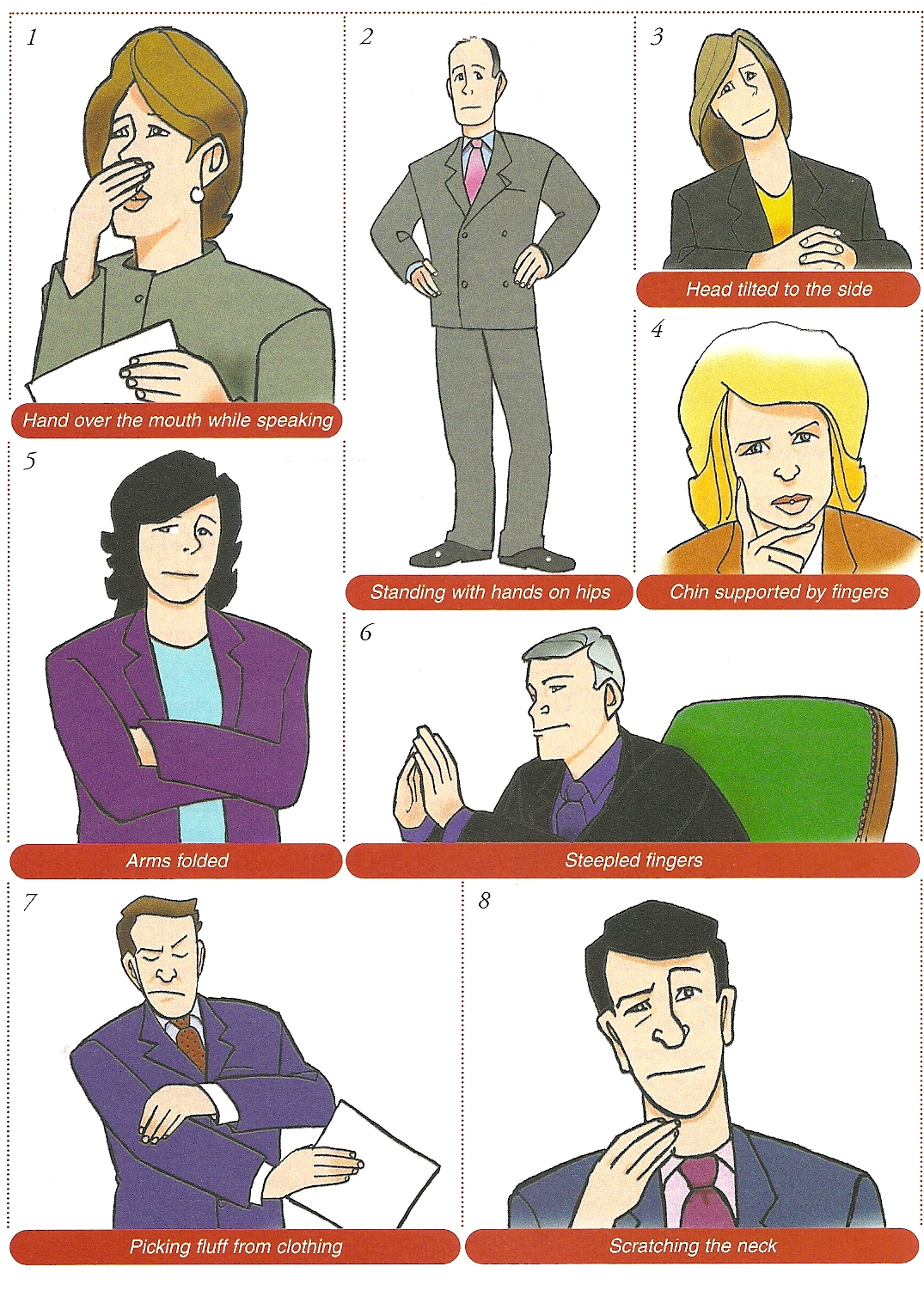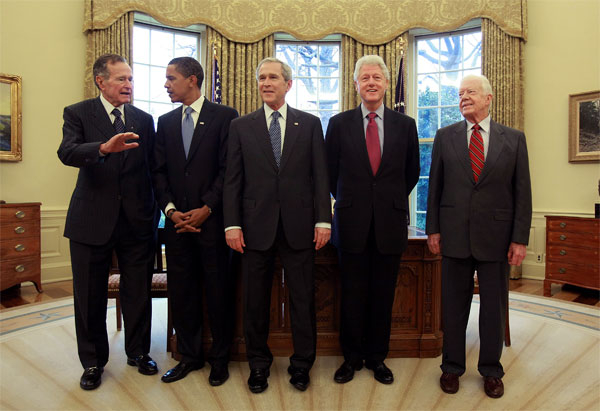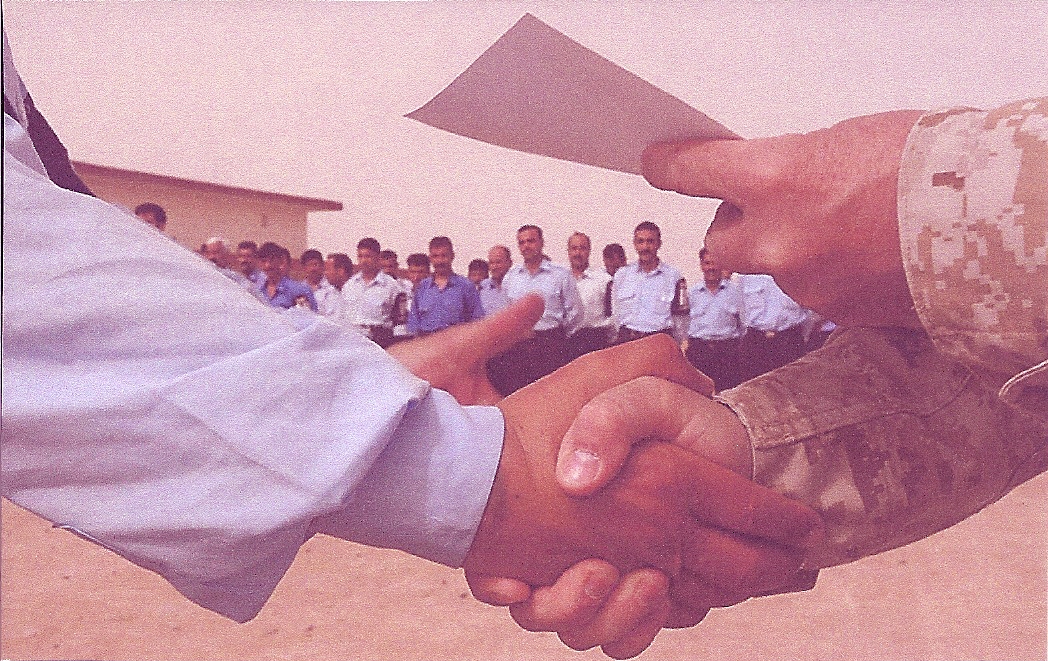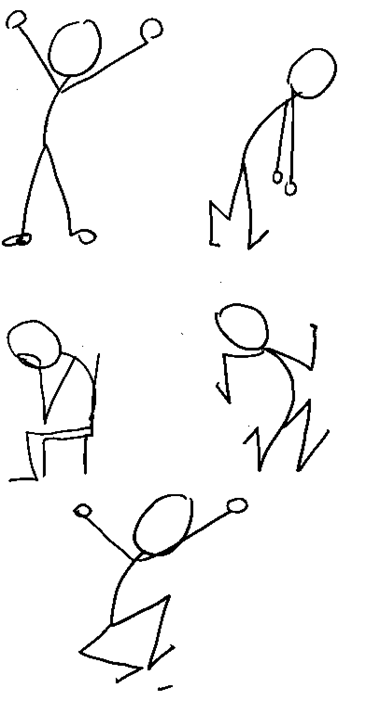
- •Improving Communications
- •Oral communications
- •Written communications
- •7 Tips to become a Good Conversationalist
- •Six Common Mistakes That Spoil Conversations
- •1. Blabbermouthing
- •2. The "take-away" and "me-too" syndrome
- •3. Unsolicited advice
- •4. Interrupting
- •5. Contradicting
- •6. Stingy contributors
- •8 Правил знайомства з діловими партнерами
- •18 Ways to improve your body language
- •6 Чарівних букв
- •Voice and Language
- •Visual aids
- •Fail to prepare
- •No weak opening
- •When I know I have to make a presentation, even a small one before a very limited number of people, I start feeling nervous…
- •When a big meeting is coming up, one that will involve a number of presentations from a range of people…
- •I would say my ability as a presenter is…
- •While I am up on stage, I…
- •Comments about my presentations are generally…
- •If I have to go “off the cuff”…
- •If I could describe public speaking as a food, it would be…
- •Visual aids versus handouts
- •Я к вдало провести ділову зустріч.
- •Introducing the Agenda
- •Introducing the First Item on the Agenda
- •1. What is the desired outcome of the meeting? (How will you know the meeting was successful?)
- •2. Who needs to be there? (And who doesn’t?)
- •3. Is the agenda prepared? (If not now, when?)
- •4. What can I do to prepare? (How can I help others prepare?)
- •5. What can I do to make this meeting succeed? (What is my responsibility?)
- •Discuss the following questions:
- •Exercise 6
- •Negotiating
- •Well, we could make it 7,5 % .
- •The trouble is, the general manager isn't very interested in marketing. He's only concerned about …..5…... If you make it 10%, I might be able to persuade him.
- •But you said…
- •6 Найпоширеніших помилок при проведенні переговорів
- •Communicating with someone in writing
- •The salutation
- •The subject title
- •The body of the letter
- •The parting
- •The signature
- •Inquiries (Enquiries)
- •Поради при написанні ділових листів
- •……………: Always proofread and edit your letters.
- •Avoid the use of …..1….. Words
- •Informal Style Formal Style
- •Identify yourself, if necessary
- •Include necessary information
- •Ten keys to writing an essay
- •Budget your time carefully
- •Read the topic carefully
- •Plan your essay before you write
- •Be sure your handwriting is as clear and legible as possible
- •Follow a clear, logical organization
- •Topic Type a: Contrast/Opinion
- •Use concrete examples and specific reasons
- •Use signal words to indicate transitions
- •Use a variety of sentence types.
- •Check your essay for errors.
- •Електронна пошта
- •Chief, Guy, Sport
- •My Buddy
- •Assumption Junction
- •Peak-a-Boo
- •2 (Suggested answer)
- •Listening 4
- •Contents
- •References
8 Правил знайомства з діловими партнерами
Люди - соціальні істоти і відсутність хороших навичок спілкування може призвести до самотності. Під час вітання ми збентежені і схвильовані, замість того, щоб задуматися про те, що нові знайомства можуть подарувати нам зустріч з майбутніми друзями чи діловими партнерами. Втім, соціальні навички піддаються тренуванню. Найважливіше - навчитися робити перший крок. Журнал Forbes пропонує 8 простих порад на цю тему.
Встановіть зоровий контакт. Перший крок - ключ до успіху. Відсутність упевненості в собі і тривожний вираз обличчя не підвищать ваш рейтинг (якщо ви, звичайно, не Вуді Аллен). Кращий спосіб здаватися упевненою людиною (навіть якщо ви нею не є) - першим встановити зоровий контакт з майбутнім співрозмовником, супроводжуючи його теплою (але не підлесливою!) усмішкою.
Знайдіть знайомі риси. Якщо ви відчуваєте стрес перед тим, як відрекомендуватися незнайомцеві, спробуйте піти на невелику хитрість. Уважно вдивіться в нього і спробуйте відшукати знайомі риси. Можливо, його усмішка схожа на усмішку вашого кращого друга, або колір волосся точнісінько, як у вашої матері. Сфокусувавши увагу на схожих рисах, ви непомітно для самого себе розслабитеся і спокійно поспілкуєтеся з незнайомою людиною.
Спочатку слухайте, потім говоріть. Вирішивши приєднатися до цілої групи незнайомих людей, не треба уриватися в їхнє тісне коло з грацією слона і новою темою для розмови. Краще прислухайтеся до того, про що вони говорять і в потрібний момент вставте репліку, яка допоможе розмові розвиватися і далі. Перші секунд 10 буде трохи ніяково, зате, не встигнете ви схаменутися, як потискуватимете руки новим знайомим.
Обговоріть загальні проблеми. Це старе як світ правило працює скрізь, від нарад до готельних барів. Скажіть, ні до кого особливо не звертаючись, щось подібне до: "Як же набридли ці нескінчині затори!" і озирніться у пошуках підтримки. Який-небудь товариш по нещастю обов'язково відгукнеться, підтримає розмову про завантаженість доріг, і ось вже через півгодини ви базікатимете про те і про це.
Поступіться ініціативою. Багато хто не може почати розмову, побоюючись того, що їхня ініціатива буде прийнята за агресивність. Уникнути такої реакції співрозмовника дуже просто: відволічіть його увагу на самого себе, хай він стане центром розмови. Спитайте питання про нього самого, зробіть комплімент. Люди егоцентрічні, використовуйте це як перевагу для себе.
Сфокусуйтеся на співрозмовнику. Окрім компліментів чужому егоцентризму, є ще одна перевага у відволіканні розмови на співрозмовника - це розкриє вас. Коли ви фокусуєтеся на собі, то постійно думаєте про те, що почервоніли, що у вас пітні долоні, що ви не знаєте, куди подіти руки і заїкаєтеся, відповідаючи на просте питання. Тривожний стан посилиться, і розмова відразу зайде в безвихідь. Фокусуючись на співрозмовнику, ви відволікаєтеся від власних емоцій і спокійно спілкуєтеся.
Тренуйтеся. Пара-трійка розмов-тренувань з друзями перед важливою нарадою або корпоративним святом не зашкодять. Планувати і проговорювати про себе те, що ви хочете сказати, допомагає сконцентруватися на завданні і відчути впевненість у власних силах, зробити перший крок, спілкуючись з незнайомими людьми.
Пам'ятайте: ми всі в одному човні. Більшість людей, так чи інакше, дещо скуті в спілкуванні і мають підвищений рівень соціальної стурбованості. Якщо тільки вашого співрозмовника звуть не Джордж Клуні, він теж цілком може нервувати і відчувати себе некомфортно в товаристві незнайомих людей. Пам'ятайте, що в цьому сенсі ми всі знаходимося в одному човні: так зробіть перший крок.
2
|
ршеності, розуміння і схвалення.
|
|
|
Would you like to know whether someone likes you or not, even before they say a word? Do you want to know anyone's thoughts and feelings by reading their body language? Do you want to subconsciously influence anyone... without even saying a single word? If you answered "yes" to any of the questions above, then this unit could be the most crucial message you'll ever read in your life. Here's why.
In just a few minutes from now, you could have the unique ability to easily read and interpret body language cues of anyone.
This means you could almost instantly know if they're being honest or deceitful... if they like you or not... or whatever they might be thinking or feeling at the moment - simply by observing their actions and body movements! Amazing, isn't it?
But that's not all...
Since nonverbal communication is between 60 to 75% of the impact of a message, you could use the power of body language to become tremendously successful... in your career, business, relationships, love life, and anything else that involves interacting or communicating with people.
A
Quotations on non-verbal communication
Give your comments on the quotations below.
I speak two languages: Body and English.
If you smile make certain to involve your eyes.
Talk low, talk slow, and don’t talk too much.
The time to stop talking is when the other person nods his head affirmatively but says nothing.
Anger is the feeling that makes your mouth work faster than your mind.
The wise man, even when he holds his tongue, says more than the fool when he speaks.
It’s not what you say; it’s how you say it.
It’s a mistake to think we listen only with our ears. It’s much more important to listen with the mind, the eyes, the body, and the heart.
B
On the basis of his research while he was a professor of psychology at the university of Los Angeles, Albert Mehrabin developed this formula to describe how communication works.
7% of the meaning of a message is contained in the words that you actually say.
38% of the meaning is communicated by your tone of voice.
55% of the meaning comes from visual cues like posture, gesture and expression.
From your experience would you agree with professor Mehrabian’s formula? Explain why or why not?
C
In his book about Silicon Valley, The New Thing, this is how Michael Lewis describes one of the computer industry’s leading business figures.
He had mastered the unnaturally sincere tone of voice of the Professional Man. When he wished to indicate seriousness, he dropped his chin down to his throat. When he took you aside to have a word, he looked and sounded as if he was giving a speech to an audience of a thousand people. To stress his points, which were rarely pointed or stressful, he’s pressеd his thumb against his forefinger as if he has just caught a fly by the wing. He wore suits. He hated strife. He loved consensus, or at any rate the idea of it.
When you’ve read the text, do the following:
Take turns to say this sentence in the style of the businessman described. Try to copy both his body language and his tone of voice.
Do you know anyone who acts in a similar way? Are you impressed by this kind of ‘Professional Man’? Explain why or why not.
If a businesswoman was trying to be a ‘Professional Woman’, how do you think that her body language might be different?

D
So what is body language? Give your definition of the term and communicate it to your partner. Then read 4 definitions of ‘Body language’. Discuss them with your partner. Is it different from yours? Choose the best one and memorize it.
The Oxford English Dictionary definition is:
"Body language - noun - the conscious and unconscious movements and postures by which attitudes and feelings are communicated [for example]: his intent was clearly expressed in his body language."
The Oxford Business English Dictionary offers a slightly different definition. Appropriately and interestingly the Oxford Business English Dictionary emphasizes the sense that body language can be used as a tool, rather than being an involuntary effect with no particular purpose:
"Body language - noun - the process of communicating what you are feeling or thinking by the way you place and move your body rather than by words [for example]: The course trains sales people in reading the customer's body language."
The OED dictionary definition of kinesics - the technical term for body language - depends on the interpretation of 'non-verbal communication':
"Kinesics - the study of the way in which certain body movements and gestures serve as a form of non-verbal communication."
We could define body language more fully as:
"Body language is the unconscious and conscious transmission and interpretation of feelings, attitudes, and moods, through:
body posture, movement, physical state, position and relationship to other bodies, objects and surroundings,
facial expression and eye movement, (and this transmission and interpretation can be quite different to the spoken words)."
E
Check some of the following non-verbal cues and you’ll recognize that you already speak and translate much of the language.
Match the pictures with what people say or think.
|
|
|
|
|
"Well, I'm shocked!" "All right!"
|
|
|
"I don't know why I even bother going out with you!"
|
|
|
|
|
"Bummed." "Listen up." |
|
|
|
|
"Dunno." (don’t know) "I'm surprised!" "You're wrong!" "No, you're wrong!" |
|

Are you a language specialist?
Test your knowledge of body language. Choose a, b, c, or d; then compare your answers with your group mates
1. When your colleague crosses his/her arms during a meeting …
a) he/she is cold
b) he/she is disagreeing with what is being said
c) he/she is listening attentively
d) all the answers above are possible
2. When a boy and a girl walk hand in hand …
a) her hand is usually in front
b) his hand is usually in front
c) it differs from time to time whose hand is in front
d) there is no front or back while holding hands
3. Someone who glances sideways when thinking …
a) remembers a certain feeling
b) has a particular picture in mind
c) remembers a taste or smell from the past
d) is thinking about what is being said
4. A baby’s first smile …
a) is reflexive behaviour
b) is a sign of happiness
c) is a sign of copying the parent
d) is a sign of recognition
5. Most conversations take place in …
a) the intimate zone
b) the personal zone
c) the social zone
d) the public zone
6. An equal handshake means …
a) your hand is on top of the other person’s hand
b) your hand is below the other person’s hand
c) your hand is in vertical position
d) you greet using both your hands
7. Raising an eyebrow can convey…
a) recognition or surprise
b) sadness
c) anger
d) disgust
8. During a conversation, body language especially says something about …
a) the intelligence of the speakers
b) the content of the message
c) the relationship of the people speaking
d) the health of the people
9. During a personal conversation (face-to-face) …
a) body language is more important than the words spoken
b) the words are more important than body language
c) it’s possible to communicate without using body language
d) body language and spoken language complement each other
Answers:
1c 2b 3d 4a 5b 6c 7a 8c 9d
![]()
Body language or NVC
1. Listen to the lecture and categorize 5 kinds of non-verbal communication.
NVC
|
2. Listen again and fill in the missing words in the sentences 1-8.
There is another form of …………..which we all use most of the time.
It’s more ……………name is non- verbal communication, NVC for ………… .
NVC signals are sometimes …………… into 5 kinds.
Proximity simply means …………… .
Some signals are probably ……………to all of us.
All signals can be …………… .
You can even learn to give ……………signals.
In fact, non-verbal communication can speak …………… .
3. Summarize what you have learnt from the lecture.
Body Language Speaks Volumes
Pre-reading
|
|
1) NVC 2) proxemics 3) chronemics 4) kinesics 5) posture 6) gesture 7) haptics 8) oculesics 9) paralanguage
|
|
3. Find in the text the answers to the questions below:
What is NVC and how it can be communicated?
What sends messages during interaction?
What is proxemics and how it can be categorized?
What do time perceptions include?
What is the impact of posture on interpersonal relationships?
How do you understand ‘mirror-image’ postures?
In what way can gestures be articulated?
What is haptics?
What is the attitude towards touches in different countries?
In what way can paralanguage change the meaning of words?
Can you give some tips on how to read body language?
Body Language Speaks Volumes
Non-verbal communication (NVC) is usually understood as the process of communication through sending and receiving wordless messages.
NVC can be communicated through gesture and touch, by body language or posture, by facial expresion and eye contact. NVC can be communicated through object communication such as clothing, hairstyles or even architecture, symbols and graphics. Speech contains non-verbal elements known as paralanguage, including voice quality, emotion and speaking style, as well as prosodic features such as rhythm, intonation and stress.
Elements such as physique, height, weight, hair, skin color, gender, odors, and clothing send non-verbal messages during interaction.
Environmental factors such as furniture, architectural style, interior decorating, lighting conditions, colors, temperature, noise, and music affect the behavior of communicators during interaction. The furniture itself can be seen as a non-verbal message.
Proxemics is the study of how people use and percieve the physical space around them. The space between the sender and the receiver of a message influences the way the message is interpreted.
The perception and use of space varies significantly across cultures and different settings within cultures. Space in non-verbal communication may be divided into four main categories: intimate, social, personal and public space. The distance between communicators will also depend on sex, status and social role.
Chronemics is the study of the use of time in non-verbal communication. Time perceptions include punctuality and willingness to wait, the speed of speech and how long people are willing to listen. The timing and frequency of an action as well as the tempo and rhythm of communications within an interaction contributes to the interpretation of non-verbal messages.
Kinesics is the study of body movements, facial expressions and gestures. Kinesics behaviors include mutual gaze, smiling, facial warmth or pleasantness, childlike behaviors, direct body orientation, and the like.
Posture can be used to determine a participant’s degree of attention involvement, the difference in status between communicators, and the level of fondness a person has for the other communicator. Studies investigating the impact of posture on interpersonal relationships suggest that morror-image congruent postures, where one person’s left side is parallel to the other’s right side, leads to favorable perception of communicators and positive speech; a person who displays a forward lean or decrease in a backwards
Lean also signifies positive sentiment during communication. Posture is understood through such indicators as direction of lean, body orientation, arm position, and body openness.
Gesture is a non-vocal bodily movement intended to express meaning. They may be articulated with the hands, arms or body, and also include movements of the head, face and eyes, such as winking, nodding, or rolling ones’ eyes.
Haptics is the study of touching as non-verbal communication. Touches that can be defined as communication include handshakes, holding hands, kissing (cheek, lips, hand), back slapping, a pat on the shoulder, and brushing an arm. Touching of oneself may include licking, picking, holding, and stratching. These behaviors are referred to as “adaptor” and may send messages that reveal the intentions or feelings of a communicator.
The study of the role of eyes in non-verbal communication is sometimes referred to as “oculesics”. Eye contact can indicate interest, attention, and involvement. Gaze comprises the actions of looking while talking, looking while listening, amount of gaze, and frequency of glances, patterns of fixation, pupil dilation, and blink rate.
Paralanguage (sometimes called vocalics) is the study of non-verbal cues of the voice. Various acoustic properties of speech such as tone, pitch and accent can all give off non-verbal cues. Paralanguage may change the meaning of words. How to read body language? Up to 93 % of communication is non-verbal. Including tone of voice, eye movement, posture, hand gestures, facial expressions and more. The pressure of body language can especially be felt in emotional situations. Body language usually prevails over words. Are you good at reading body language? The eyes communicate more than any other part of the human anatomy. Staring or gazing at others can create pressure and tension in the room. Maintained eye contact can show if a person is trustworthy, sincere or caring. Shifty eyes, too much blinking can suggest deception. The smile: There are 50 or so different types of human smiles. By analyzing the movements of over 80 facial muscles involved in smiling, researchers can tell when a smile is true. Look for the crinkle in the skin at the middle, outside corner of the eyes and if it is not there, the smile is probably fake. Bodily cues are the most reliable of all nonverbal signals of deception to help you read body language. This is because a person generally has less conscious control over these than other signals. Hand-to-face gestures and shrugs are strong markers of deception. Space is important. Personal space is needed and if it is invaded intentionally and at times by oversight can cause an individual to feel uncomfortable or threatened. Gestures communicate. Hand signals can communicate without the use of any speech. Touching communicates. Touching can be friendly or it can be aggressive. The way a person stands reflects their level of confidence and comfort level. If a person stands tall so to speak he is seen as more confident. If someone is standing with their hands on their hips that can indicate aggression or alertness. |
The Importance of Non-Verbal Communication
For instance, it’s not always just what you say. It’s also how you “say” it – taking into account your eyes, your posture, your overall body language, even your appearance at the time the communication is exchanged, and the voice in which you offer the exchange.
Reading comprehension
Exercise 1
Complete the sentences.
Non-verbal communication is usually understood as …
NVC can be communicated through …
The perception and use of space varies …
Space in non-verbal communication may be divided into …
Time perceptions include …
Posture can be used to …
Posture is understood through …
Gestures may be articulated with …
Eye contact can indicate …
Exercise 2
Define the sentences as True or False
The lips communicate more than any other part of the human anatomy.
There are 50 types of human smile.
Over 18 facial muscles are involved in smiling.
Hand-to-face gestures are strong markers of honesty.
If a person stands tall he is seen as more confident.
If someone is standing with their hands on their hips that can indicate defense.
Space is a cultural thing and can cause an individual to feel uncomfortable.
Exercise 3
Work in groups of 3 students. Choose one of the areas and explain to your partners how each of these factors may influence the process of communication.
Physical space Chronemics Environment |
Posture Gesture Facial expressions |
Eye contact Touch Paralanguage |
Translate into English.
Види комунікації
Невербальна комунікація має різні системи: оптикокінетичну, паралінгвістичну, просторово-часову, візуальний контакт та інші. Кожна з цих систем має свої особливості.
Оптикокінетична система знаків використовує жести та міміку. Велике значення у невербальній комунікації мають вираз обличчя, погляд. Певне значення мають і жести. Паралінгвістична система знаків характеризується якістю голоса і виражає почуття і стани людини. Тому голос людини може бути спокійним, збудженим, роздратованим.
Отже вербальна і невербальна комунікація тісно пов’язана між собою. Невербальна комунікація є суттєвим доповненням до вербальної комунікації і підсилює її.
Attitudes to personal space
Pair work
Look through the table below and discuss with your partner attitudes to personal space in different cultures.
Each of us has a concept of personal space and we don’t like it when someone we don’t know intrudes into our privacy. The extent and size of our personal or private space varies by culture. People with large personal space prefer to keep their distance from others.
How would you describe your culture? Do people have small or large personal space?
|
People with small personal space |
People with large personal space |
How close?
Touching
Familiarity with strangers
Personal topics
The home as private space |
stand close together when talking
often touch each other as a sign of friendliness.
are easy to get to know.
are happy to discuss personal matters with people they don’t know well.
are more likely to invite you to their home. |
feel uncomfortable when standing too close to others.
may shake hands, but don’t generally touch the people they work with.
are reserved with people they don’t know well.
don’t discuss personal matters in a business relationship.
are unlikely to invite you to their home. |
Exercise 1
For questions 1-16, read the text below and decide which word A, B, C or D best fits each space.
Body language
Language is commonly believed to be a system of communication that …1…of sounds and written symbols. However, we can also communicate …2…other ways by using our facial …3…, our tone of voice and even our …4…body. In fact, in many situations, non-verbal communication can …5…more accurately what a person is feeling. Body language always speaks the truth, …6…words can often be …7… .
For successful communication both at the office and at home, an understanding of body language is important. At work, non-verbal communication is …8…to power. People …9…charge tend to lean …10…in their chairs, fold their hands behind their heads and …11…their feet up on the desk. They usually …12…conversations, both talking and interrupting more than others. Those who …13…orders, on the other hand, are much less relaxed and tend to sit on the …14…of their chairs with their arms tightly folded.
Body language plays an equally important role at home. Children are particularly quick to pick …15…on non-verbal signals and can distinguish …16…what is said and what is really meant.
1 2 3 4 5 6 7 8 9 10 11 12 13 14 15 16 |
A exists A to A expressions A full A explain A whereas A senseless A associated A at A back A put A overwhelm A do A top A out A between |
B consists B for B shapes B whole B announce B so B hopeless B related B on B behind B lay B master B give B edge B over B among |
C contains C in C looks C partial C reveal C except C mistrustful C combined C by C away C deposit C dominate C lead C limit C up C from |
D includes D by D aspects D total D publish D therefore D misleading D reserved D in D against D lie D hold D follow D border D at D that |
Exercise 2
Work in groups of 3-4 students. Read and show all body language signs. Then in turn ask your partners to demonstrate some signs (e.g. show the signs of frustration, or boredom, or interest, etc).
eyes
mouth
head
arms
hands
legs
|
honesty or faked honesty interest, appeal disbelief or tiredness excitement, pressure greeting, recognition, acknowledgement friendly acknowledgement, or sharing a secret or joke
faked smile mixed feelings or sarcasm relaxation tension self-comforting suppression, shock frustration, suppression
attentive listening superiority, arrogance non-threatening, thoughtfulness interest, positive reaction criticism pride, confidence
hostile defensiveness insecurity confidence, authority nervousness nervousness nervousness
nervousness nervousness
honesty authority, strengths, dominance striving for or seeking an answer
seeking to be believed aggression, threat, emphasis warning, refusal satisfaction “OK” positive approval disapproval, failure anticipation, relish lying or exaggerating rejection of, or resistance to something indecision, self-comforting thoughtfulness evaluation, tiredness or boredom doubt, disbelief confidence, readiness boredom dominance submission seeking to convey trustworthiness non-threatening, relaxed
openness caution, disinterest defensiveness |
Exercise 3
Match the gestures with heir meanings
|
|
Exercise 4
How would you interpret the gestures shown in these cartoons?

Exercise 5
Try to guess the interpretation of non-verbal behavior.
Non-verbal behavior Interpretation
|
|
![]()
Translate into Ukrainian.
Other forms of body language which influence the meaning include such things as turning away from someone, closing your eyes, standing further away, waving, pointing, strumming your fingers on the table, resting your head in your hand while talking/listening, etc. These actions can signal the difference between interest and disinterest, patience and impatience, attending and ignoring, defensiveness and openness, aggressiveness and passiveness, and so forth.
These may seem like small nuances, but if you remember that communication isn’t just about what you say, then you will do a better job of communicating what you mean.
Reading presidential body language
1. Look at the picture. Have you recognized all people? What can you read from their body language?

2. Read the description of the photo. Is it different from yours?
I find the photo above to be fascinating as a study in body language. George W. Bush stands front and center, but seems nervously out-of-place, with his awkward smirk and cocked left foot. Barack Obama is both leaning and looking away from the George W. Bush speaking with his father. There is a strange stiffness in his comportment. GHWB stands at the end, hand outstretched in mid-sentence, in a position that suggests either patting a child on the head or pushing them away.
Bill Clinton stands grinning wistfully, hands behind his back, contemplating, perhaps, his own personal history (and I mean personal) in the very room in which the five men now stand.
And Jimmy Carter knows exactly what’s on Bill’s mind.
I’ll leave you to ponder the merits, or lack thereof, of my decision to omit an apostrophe in the phrase “Presidents Club.”
3. Can you name any celebrities whose body language is easily recognizable? Give some examples.

 асто
проблеми у спілкуванні виникають
з двох полярних причин: сором'язливість
і надмірна балакучість. Причому
людям з другою проблемою простіше,
ніж сором'язливим, оскільки вони
рідше замислюються над тим, чому
з ними не хочуть спілкуватися, ніж
ті, у яких є час помовчати і все
осмислити.
асто
проблеми у спілкуванні виникають
з двох полярних причин: сором'язливість
і надмірна балакучість. Причому
людям з другою проблемою простіше,
ніж сором'язливим, оскільки вони
рідше замислюються над тим, чому
з ними не хочуть спілкуватися, ніж
ті, у яких є час помовчати і все
осмислити.









